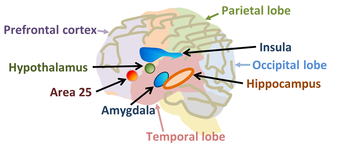Mind-body problem
The mind-body problem is the philosophical and scientific consideration of the relation between conscious mental activity such as judgment, volition, and emotion and the underlying physical plant that supports this activity, consisting primarily of the brain (seen as a complex of neurons, synapses and their dynamic interactions), but also involving various sensors throughout the body, most notably the eye, ear, mouth, and nose.
A distinction is often made in the philosophy of mind between the mind and the brain, and there is some controversy as to their exact relationship. Narrowly defined, the brain is defined as the physical and biological matter contained within the skull, responsible for all electrochemical neuronal processes. More broadly defined, the brain includes the dynamical activity of the brain, as studied in neuroscience. The mind, however, is seen in terms of mental attributes, such as consciousness, will, beliefs or desires. Some imagine that the mind exists independently of the brain, and some believe in a soul, or other epiphenomena. In the field of artificial intelligence, or AI, so called strong AI theorists, say that the mind is separate from the brain in the same way that a computer algorithm exists independent of its many possible realizations in coding and physical implementation, and the brain and its 'wiring' is analogous to a computer and its software.[1]
The brain

Some human brain areas; some of the labeled areas are buried inside the brain. Area 25 refers to Brodmann's area 25, a region implicated in long-term depression.
The brain is hugely complex, with perhaps as many as 10,000 different types of neuron, each with different intrinsic properties that use many different signalling systems. Altogether in the human brain there are several billion neurons, each making perhaps 10,000 synaptic connections - but as well as communication by synapses these neurons also intercommunicate by autocrine, paracrine, and neurohormonal chemical signals. Neuroscientists believe that neurons and the(mainly) chemical signals that pass between them are the fundamental units of information in the brain, that these signals interact with the intrinsic properties of individual neurones to generate patterns of electrical activity within those neurons, and that these patterns in turn determine what chemical messengers are made and when they are released. Experience alters the patterns and strengths of connectivity between neurons, and neuroscientists believe that this is the basis of learning.
Mind
Neuroscientists have found that some patterns of neural network activities correlate with some mental states, and have identified regions of the brain that participate in various personality disorders, mood disorders, addictions, and dementias, such as Alzheimer's disease. The figure shows a sampling of the many known human brain areas. Brodmann labeled many more. Brodmann's area 25 located deep in the frontal lobe is implicated in long-term depression. The prefrontal cortex is involved in decision making, judgment, planning for the future. The amygdala is involved in emotion. The hippocampus is involved in memory. The insula is involved in bodily somatic sensations; it receives and interprets sensory information from organs in the joints, ligaments, muscles, and skin. The hypothalamus is involved in appetite and drive. It should be noted, however, that the activities of these regions are not entirely localized, but are coupled by the brain's circuitry, not in a static, fixed manner, but in an ever-changing dynamic manner.
Conventionally, neuroscientists assume that consciousness ("self awareness") is an emergent property of computer-like activities in the brain's neural networks, a view called connectionism. In massively complex systems like the brain, complexity can give rise to unexpected higher order activities, so-called emergent properties, not easily foreseen from the properties of individual neurones, but related to their cooperative behavior. Such emergent properties are very difficult to work with and understand, precisely because they arise unpredictably in highly complex systems. Nevertheless, an important part of contemporary neuroscience is the understanding of neuronal networks and the relations between network behaviour and the behaviour of single cells, and to study how higher order behaviors emerge from the properties of the component units from which networks are built.
Dualism
Interest in the mind-body problem has a history going back many millenia, with some of the early writing credited to the Stoics who believed in fate determining the course of events, and yet felt one must as a matter of being human, think through one's choices.[2] This division has been re-invented over and over again in various forms of dualism,[3] encompassing various attempts to answer the question "What makes us who we are?",[4] one issue being the interpretation of the experience of conscious intention or free will.
References
- ↑ John R Searle (1997). John Haugeland, ed: Mind Design II: Philosophy, Psychology, and Artificial Intelligence, 2nd ed. MIT Press, p. 203. ISBN 0262082594.
- ↑ Chrysippus (279 – 206 BC) attempted to reconcile the inner with the outer worlds by suggesting the mind ran under different rules than the outer world. See for example, Keimpe Algra (1999). “Chapter VI: The Chyrsippean notion of fate: soft determinism”, The Cambridge History of Hellenistic Philosophy. Cambridge University Press, p. 529. ISBN 0521250285.
- ↑ Robinson, Howard (Nov 3, 2011). Edward N. Zalta ed:Dualism. The Stanford Encyclopedia of Philosophy (Winter 2011 Edition).
- ↑ Joseph E. LeDoux (2003). “Chapter 1: The big one”, Synaptic Self: How Our Brains Become Who We Are. Penguin Books, p. 1 ff. ISBN 0142001783.